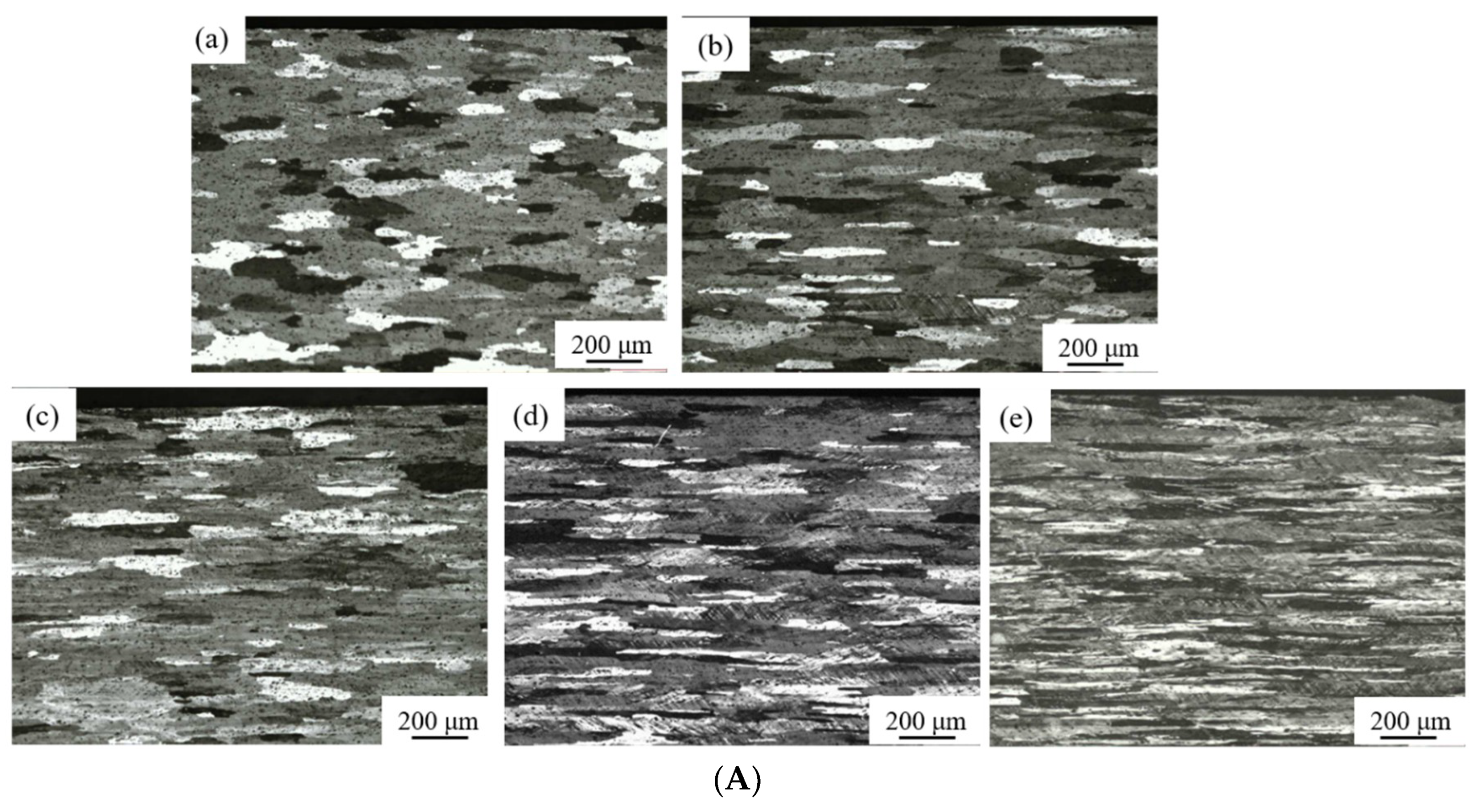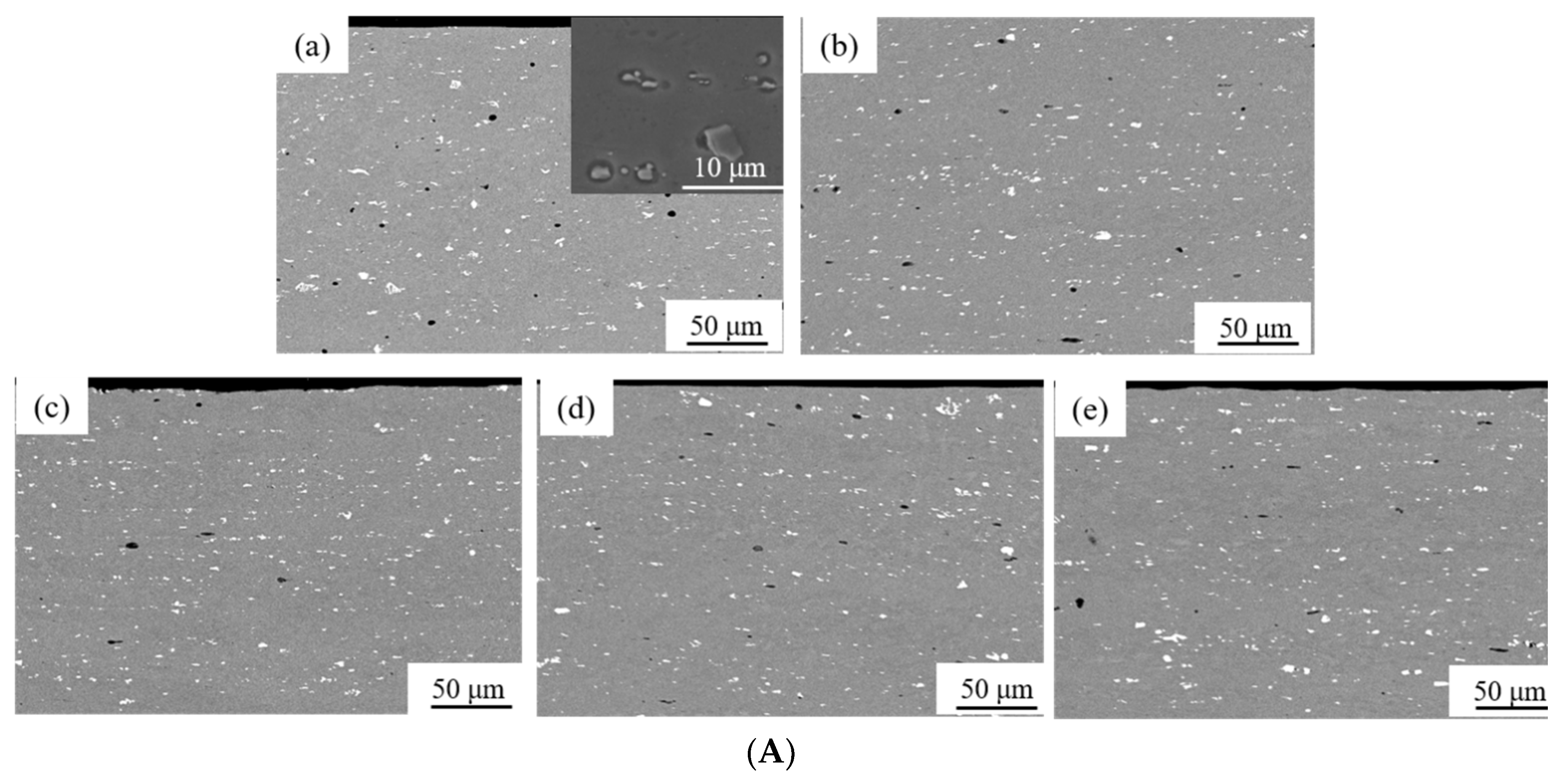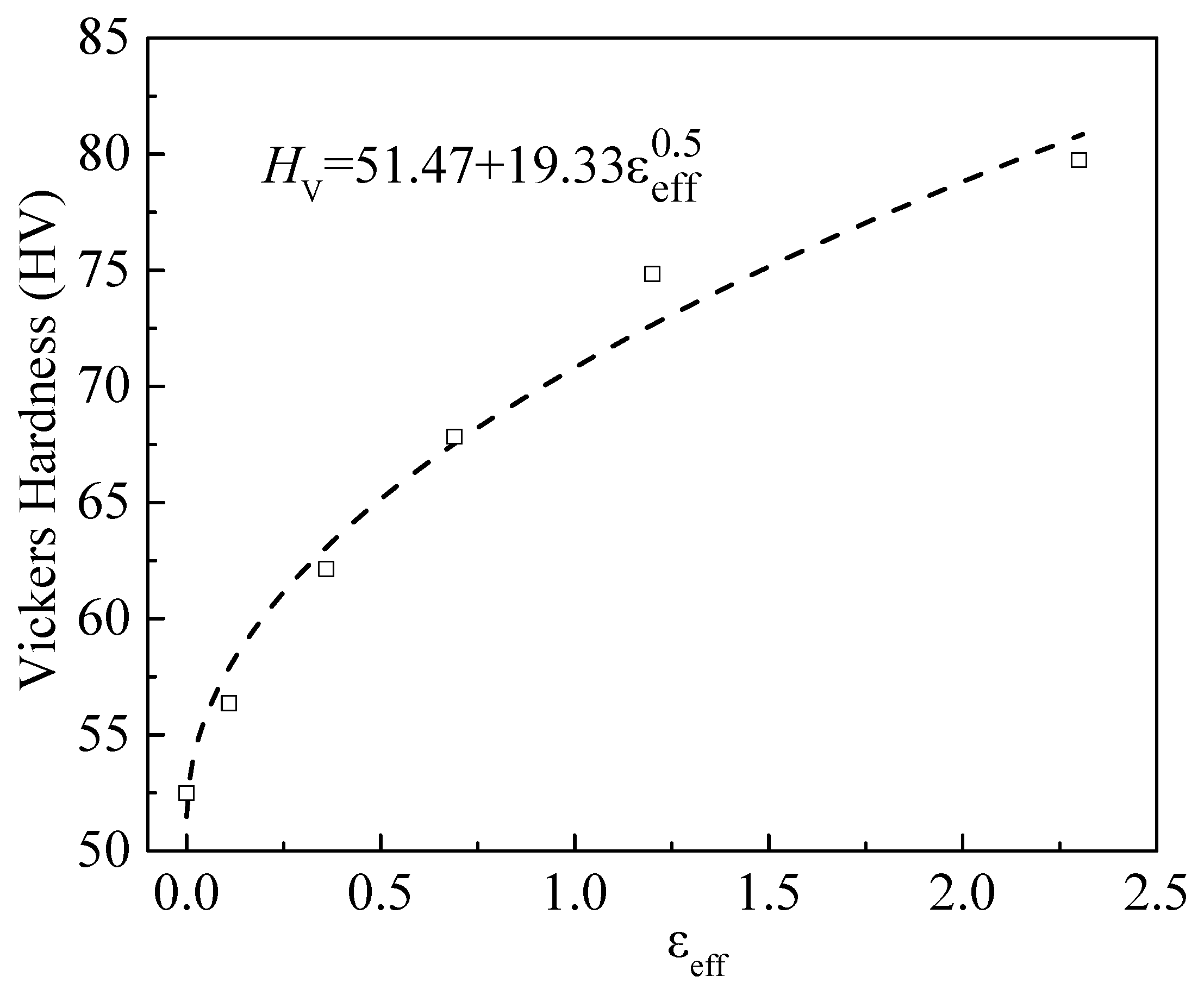Local Deformation and Texture of Cold-Rolled AA6061 Aluminum Alloy
Abstract
1. Introduction
2. Materials and Methods
3. Results and Discussion
3.1. Texture Analysis
3.2. Indentation Deformation
4. Conclusions
Author Contributions
Funding
Acknowledgments
Conflicts of Interest
References
- Engler, O.; Schäfer, C.; Brinkman, H.J. Crystal-plasticity simulation of the correlation of microtexture and roping in AA6xxx Al-Mg-Si sheet alloys for automotive applications. Acta Mater. 2012, 60, 5217–5232. [Google Scholar] [CrossRef]
- Muraoka, Y.; Miyaoka, H. Development of an all-aluminum automotive body. J. Mater. Process. Technol. 1993, 38, 655–674. [Google Scholar] [CrossRef]
- Miller, W.; Zhuang, L.; Bottema, J.; Wittebrood, A.J.; De Smet, P.; Haszler, A.; Vieregge, A. Recent development in aluminium alloys for the automotive industry. Mater. Sci. Eng. A 2000, 280, 37–49. [Google Scholar] [CrossRef]
- Cole, G.; Sherman, A. Light weight materials for automotive applications. Mater. Charact. 1995, 35, 3–9. [Google Scholar] [CrossRef]
- Hirsch, J. Aluminium in innovative light-weight car design. Mater. Trans. 2011, 52, 818–824. [Google Scholar] [CrossRef]
- Schäfer, C.; Brinkman, H.-J.; Engler, O.; Nitzsche, G.; Keller, S. Methodology for quantification of the roping phenomena in 6xxx automotive car body sheet alloys. Mater. Sci. Forum 2014, 794–796, 45–50. [Google Scholar] [CrossRef]
- Beaudoin, A.; Bryant, J.; Korzekwa, D.A. Analysis of ridging in aluminum auto body sheet metal. Metall. Mater. Trans. A 1998, 29, 2323–2332. [Google Scholar] [CrossRef]
- Baczynski, G.; Guzzo, R.; Ball, M.; Lloyd, D. Development of roping in an aluminum automotive alloy aa6111. Acta Mater. 2000, 48, 3361–3376. [Google Scholar] [CrossRef]
- Wittridge, N.; Knutsen, R. A microtexture based analysis of the surface roughening behaviour of an aluminium alloy during tensile deformation. Mater. Sci. Eng. A 1999, 269, 205–216. [Google Scholar] [CrossRef]
- Engler, O.; Hirsch, J. Texture control by thermomechanical processing of AA6xxx Al-Mg-Si sheet alloys for automotive applications—A review. Mater. Sci. Eng. A 2002, 336, 249–262. [Google Scholar] [CrossRef]
- Kashihara, K.; Tsujimoto, Y.; Terada, D.; Tsuji, N. Texture evolution in {112}<111> aluminum single crystals processed by severe plastic deformation. Mater. Charact. 2013, 75, 129–137. [Google Scholar] [CrossRef]
- Toroghinejad, M.R.; Ashrafizadeh, F.; Jamaati, R.; Hoseini, M.; Szpunar, J.A. Textural evolution of nanostructured AA5083 produced by ARB. Mater. Sci. Eng. A 2012, 556, 351–357. [Google Scholar] [CrossRef]
- Shabadi, R.; Suwas, S.; Kumar, S.; Roven, H.; Dwarkadasa, E. Texture and formability studies on AA7020 Al alloy sheets. Mater. Sci. Eng. A 2012, 558, 439–445. [Google Scholar] [CrossRef]
- Yu, H.; Su, L.; Lu, C.; Tieu, K.; Li, H.; Li, J.; Godbole, A.; Kong, C. Enhanced mechanical properties of arb-processed aluminum alloy 6061 sheets by subsequent asymmetric cryorolling and ageing. Mater. Sci. Eng. A 2016, 674, 256–261. [Google Scholar] [CrossRef]
- Yang, F.; Du, W.; Okazaki, K. Effect of cold rolling on the indentation deformation of AA6061 aluminum alloy. J. Mater. Res. 2005, 20, 1172–1179. [Google Scholar] [CrossRef]
- Mohamed, I.F.; Lee, S.; Edalati, K.; Horita, Z.; Hirosawa, S.; Matsuda, K.; Terada, D. Aging behavior of al 6061 alloy processed by high-pressure torsion and subsequent aging. Metall. Mater. Trans. A 2015, 46, 2664–2673. [Google Scholar] [CrossRef]
- Yu, H.-L.; Tieu, A.K.; Lu, C.; Liu, X.-H.; Godbole, A.; Kong, C. Mechanical properties of Al-Mg-Si alloy sheets produced using asymmetric cryorolling and ageing treatment. Mater. Sci. Eng. A 2013, 568, 212–218. [Google Scholar] [CrossRef]
- Burgers, W. Ber den zusammenhang zwischen deformationsvorgang und rekristallisationstextur bei aluminium. Z. Phys. 1931, 67, 605–678. [Google Scholar] [CrossRef]
- Wen, X.; Wen, W.; Zhang, Y.; Xu, B.; Zeng, Q.; Liu, Y.; Tong, L.; Zhai, T.; Li, Z. The effect of fe content on recrystallization texture evolution, microstructures, and earing of cold rolled continuous cast AA5052 alloy sheets. Metall. Mater. Trans. A 2016, 47, 1865–1880. [Google Scholar] [CrossRef]
- Zhou, D.; Zuo, D.; Wen, X.; Liang, W.; Yang, F. Through-thickness texture gradient and microhardness of cold-rolled aa6061. Mater. Res. Express 2018. [Google Scholar] [CrossRef]
- Chawla, K.K.; Meyers, M. Mechanical Behavior of Materials; Prentice Hall: Upper Saddle River, NJ, USA, 1999. [Google Scholar]










| Sample | Mg | Si | Fe | Cu | Cr | Al |
|---|---|---|---|---|---|---|
| AA6061 | 1.0 | 0.6 | 0.34 | 0.27 | 0.2 | Bal. |
© 2018 by the authors. Licensee MDPI, Basel, Switzerland. This article is an open access article distributed under the terms and conditions of the Creative Commons Attribution (CC BY) license (http://creativecommons.org/licenses/by/4.0/).
Share and Cite
Zhou, D.; Du, W.; Wen, X.; Qiao, J.; Liang, W.; Yang, F. Local Deformation and Texture of Cold-Rolled AA6061 Aluminum Alloy. Materials 2018, 11, 1866. https://doi.org/10.3390/ma11101866
Zhou D, Du W, Wen X, Qiao J, Liang W, Yang F. Local Deformation and Texture of Cold-Rolled AA6061 Aluminum Alloy. Materials. 2018; 11(10):1866. https://doi.org/10.3390/ma11101866
Chicago/Turabian StyleZhou, Diaoyu, Wenwen Du, Xiyu Wen, Junwei Qiao, Wei Liang, and Fuqian Yang. 2018. "Local Deformation and Texture of Cold-Rolled AA6061 Aluminum Alloy" Materials 11, no. 10: 1866. https://doi.org/10.3390/ma11101866
APA StyleZhou, D., Du, W., Wen, X., Qiao, J., Liang, W., & Yang, F. (2018). Local Deformation and Texture of Cold-Rolled AA6061 Aluminum Alloy. Materials, 11(10), 1866. https://doi.org/10.3390/ma11101866





